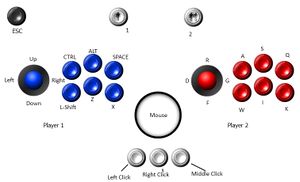Cabinet-friendliness
Cabinet-friendliness is an aspect of computer software in which every function is 100% controllable using a MAME-like arcade control interface. In the case of emulators or games, if the controls are able to be redefined to match MAME's, and the software requires no keyboard intervention, then it may be considered cabinet-friendly.
Requirements
MAME Keys
In MAME, the default keys for player 1 are: up, down, left, right, CTRL, ALT, SPACE, Left Shift, Z, X, C, V, 1, and 5 (coin); the default keys for player 2 are: R, F, D, G, A, S, Q, W, I, K, J, L, 2, and 6 (coin); and ESC is used to quit. Many keyboard encoders, such as Ultimarc's I-PAC 2 PC interface, are designed to be used directly with MAME, and therefore utilize only these keystrokes.
Mouse / Trackball
Games which are primarily controlled by a mouse may be considered cabinet-friendly, given the fact that cabinet builders often install a trackball assembly in the cabinet's control panel.
Examples of Cabinet-Friendly Software
Emulator frontends, such as Wah!Cade, are designed to be operated using the same keys as in MAME.
Many non-MAME emulators, such as ZSNES and Gens/GS, have redefinable inputs that can match MAME's.
Jukebox programs, such as MultiJuke, are specifically designed media players that are controlled by MAME's keys.
Examples of Cabinet-Unfriendly Software
Text-based graphical adventure games, such as those that brought much fame to Sierra On-Line in the 80's, get input from the player via a command parser, and therefore require a great deal of typing. Massively multiplayer online role-playing games (MMORPG), such as World of Warcraft or Guild Wars, are inherently social experiences requiring full use of a keyboard. Many modern flight simulators and first-person shooters tend to have commands mapped to nearly every key, and also require full use of a keyboard. For these reasons, as a rule these types of games would not be good candidates for inclusion in an arcade cabinet.
Emulators for modern systems, such as the Sony PlayStation or even the Nintendo 64, whose controllers can have upwards of 10 buttons, two analog joysticks, and a digital directional pad would usually not be considered cabinet-friendly. This, of course, depends entirely on the cabinet's controls.
Varying Degrees of Friendliness
Some users may feel that a certain amount of keyboard intervention is forgivable as long as it does not disrupt the natural flow of gameplay. For example, if a game requires keyboard input for the sole purpose of high-score name entry, this may be perceived as tolerable.
On the other hand, if a cabinet builder does not plan to include a keyboard in his/her finished product, or if the keyboard is inconvenient to access (e.g.: behind a locked cabinet door), then anything less than 100% cabinet-friendliness would be unacceptable.
